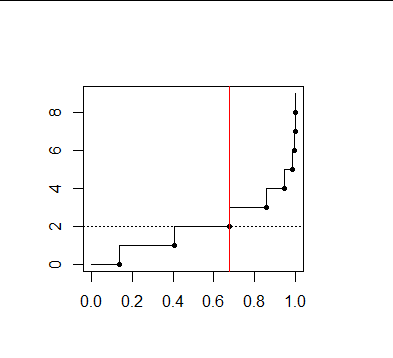The bisection method is guaranteed to work even for such discontinuous $F^{-1},$ provided it is suitably implemented.
Here is pseudocode (that actually works in R):
function(f, x, tol=1e-8, ...) {
u <- 1
l <- 0
repeat {
m <- (u + l) / 2
if (f(m, ...) - x <= 0) l <- m else u <- m
if (u - l <= tol) break # (See the end of this post for a better test)
}
return(u)
}
The arguments are (1) the name of $F^{-1},$ (2) the value of $x,$ (3) a positive error tolerance (the result will be accurate to this amount), and (4) any other arguments that need to be passed to $F^{-1}.$ I will refer to this function as findroot.
Before proving this works, let's look at how it might be used, again using R.
> findroot(qpois, 2, tol=0, lambda=2)
[1] 0.6766764
qpois is the Poisson percentile function. Thus, with $\lambda=2$ we hope that
$$0.6766764 = e^{-\lambda}(1 + \lambda + \lambda^2/2!)$$
and indeed that's the case. This figure plots part of $F^{-1},$ showing $x$ as a horizontal dashed line and the solution as a vertical red line:

Let's turn to proving this works. Let $\epsilon \ge 0$ be the tolerance. Consider the proposition
$$\mathcal{P}_{x}(l,u):\ F^{-1}(l) - x \le 0 \le F^{-1}(u) - x\quad \text{ and }\quad u^\prime > u \implies F^{-1}(u^\prime) - x \gt 0. $$
If we take the values of $F^{-1}$ at any number greater than $1$ to be $\infty,$ then $\mathcal{P}_{x}(0,1)$ is true. Assuming hypothetically $\mathcal{P}_{x}(l,u)$ at the beginning of the loop, note that $u$ will be decreased to $u^\prime$ only when $F^{-1}(u^\prime) - x \gt 0$ and in any event $F^{-1}$ changes sign between the new $l$ and new $u.$ Thus, $\mathcal{P}_{x}(l,u)$ remains true at the end of the loop. After exiting, $u$ and $l$ are within $\epsilon$ of each other and $\mathcal{P}_{x}(l,u)$ remains true (by induction). Thus, the value $t = u$ returned by findroot enjoys two properties:
$$F^{-1}(t-\epsilon)-x \le 0 \lt F^{-1}(t) - x.$$
That's what it means for $t$ to be within $\epsilon$ of a solution to $x = F^{-1}(t),$ QED.
Notice that after $n$ iterations of the loop, the difference $u-l = 2^{-n}.$ Therefore this procedure terminates after $\lceil -\log_2 \epsilon \rceil$ iterations. That's a reasonably sparing use of calls to $F^{-1}.$
In a practical application, the test u - l <= tol is too naive about floating-point roundoff error: if tol is very small (but still positive), this condition might never hold. One way to guarantee termination is to set an upper limit on the number of iterations; $52$ will be fine for double-precision arithmetic. A slightly more flexible solution in R uses zapsmall, as in
if (zapsmall(c(u - l, 1))[1] <= tol) break
When $u-l$ is indistinguishable from $0$ compared to $1,$ it is set to $0,$ guaranteeing termination of the loop.

